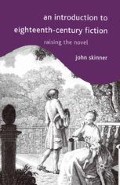Abstract
Outside conventional literary histories, the vast secondary bibliography for eighteenth-century fiction can be broadly divided into two kinds of study. One typically provides a series of elaborate readings of canonical texts, together with a conceptual model that often seems tacked on as an afterthought. The other begins with a sophisticated hypothesis, which is then applied to a select group of writers — generally some permutation of Defoe, Richardson and Fielding.1 The two approaches have accounted for much academic work over the last half-century. Within the first category, Dorothy Van Ghent’s classic study of the English novel offered valuable insights into Moll Flanders and Tom Jones, whilst its hard-nosed reading of Clarissa shocks even yet;2 Van Ghent’s interpretations are still found recycled today, although few now remember her overall thesis.3 In the second group, Nancy Armstrong’s more recent Desire and Domestic Fiction has a well-articulated thesis for her ‘political history of the novel’, although it hardly refers to any actual eighteenth-century fiction beyond the first part of Pamela.4
Preview
Unable to display preview. Download preview PDF.
Notes
Dorothy Van Ghent, The English Novel: Form and Function (New York: Harper and Row, 1953).
Nancy Armstrong, Desire and Domestic Fiction: A Political History of the Novel (New York: Oxford University Press, 1987).
Nancy Armstrong and Leonard Tennenhouse, The Imaginary Puritan: Literature, Intellectual Labor, and the Origins of Personal Life (Berkeley: University of California Press, 1992).
Ioan Williams (ed.), Novel and Romance, 1700–1800: A Documentary Record (London: Routledge & Kegan Paul, 1970).
See J. R. Moore’s A Checklist of the Writings of Daniel Defoe, 2nd edn (Hamden, Conn., 1971);
then P. N. Furbank and W. R. Owens, The Canonisation of Daniel Defoe (London, 1988) and A Critical Bibliography of Daniel Defoe.
Quoted by P. N. Furbank and W. R. Owens in Defoe: Deattributions (London: Hambledon Press, 1986), p. xvii.
Lillian Robinson, ‘Treason Our Text: Feminist Challenges to the Literary Canon’, in Elaine Showalter (ed.), The New Feminist Criticism: Essays on Women, Literature and Theory (New York, 1985).
Jane Spencer, The Rise of the Woman Novelist: From Aphra Behn to Jane Austen (Oxford: Basil Blackwell, 1986).
Dale Spender, Mothers of the Novel: 100 Good Women Writers before Jane Austen (London: Pandora Press, 1986).
Clive T. Probyn, English Fiction of the Eighteenth Century, 1700–1789 (New York: Longman, 1987).
Janet Todd, The Sign of Angellica: Women, Writing and Fiction, 1660–1800 (London: Virago, 1989).
Ros Ballaster, Seductive Forms: Women’s Amatory Fiction from 1684 to 1740 (Oxford: Clarendon Press, 1992).
April Alliston, Virtue’s Faults: Correspondences in Eighteenth-Century British and French Women’s Fiction (Stanford, Cal.: Stanford University Press, 1996).
Claudia L. Johnson, Equivocal Beings (Chicago: University of Chicago Press, 1997).
Mary Anne Schofield, Masking and Unmasking the Female Mind (Newark: University of Delaware Press, 1990).
Catherine Gallagher, Nobody’s Story: The Vanishing Acts of Women Writers in the Marketplace, 1670–1820 (Oxford: Clarendon Press, 1994).
Ian Watt, The Rise of the Novel: Studies in Defoe, Richardson and Fielding (London: Chatto and Windus, 1957).
See, for example, the findings of the Group discussed in J. Paul Hunter’s Before Novels: The Cultural Contexts of Eighteenth-Century English Fiction (New York: W. W. Norton, 1990), pp. 63–4 and pp. 112–13.
See also Percy G. Adams, Travel Literature and the Evolution of the Novel (Lexington: University Press of Kentucky, 1983).
Michael McKeon, The Origins of the English Novel, 1600–1740 (Baltimore, Md.: Johns Hopkins University Press, 1987).
Robert Scholes and Robert Kellogg, The Nature of Narrative (London: Oxford University Press, 1966).
Northrop Frye, The Secular Scripture: A Study of the Structure of Romance (Cambridge, Mass.: Harvard University Press, 1976).
Lennard J. Davis, Factual Fictions: The Origins of the English Novel (New York: Columbia University Press, 1983).
Terry Castle, Masquerade and Civilization: The Carnivalesque in Eighteenth-Century English Culture and Fiction (Stanford, Cal.: Stanford University Press, 1986).
Catherine Craft-Fairchild, Masquerade and Gender: Disguise and Identity in Eighteenth-Century Fictions by Women (University Park, Pa.: Pennsylvania State University Press, 1993).
John Bender, Imagining the Penitentiary: Fiction and the Architecture of the Mind in Eighteenth-Century England (Chicago: University of Chicago Press, 1987).
Bender draws on Michel Foucault’s Discipline and Punish: The Birth of the Prison, trans. Alan Sheridan (London: Allen Lane, 1975).
James Thompson, Models of Value: Eighteenth-Century Political Economy and the Novel (London: Duke University Press, 1996).
Margaret Anne Doody, The True Story of the Novel (London: Fontana Press, 1998).
This is effectively a political (read feminist and multi-cultural) updating of Thomas Hägg’s The Novel in Antiquity (Oxford: Basil Blackwell, 1983).
Nicola J. Watson, Revolution and the Form of the British Novel, 1790–1825 (Oxford: Clarendon Press, 1994).
Mary Poovey, The Proper Lady and the Woman Writer: Ideology as Style in the Works of Mary Wollstonecraft, Mary Shelley and Jane Austen (Chicago: University of Chicago Press, 1984).
See Gary Kelly, The English Jacobin Novel, 1780–1805 (Oxford: Clarendon Press, 1976);
Marilyn Butler, Jane Austen and the War of Ideas (Oxford: Clarendon Press, 1975;
Eleanor Ty, Unsex’d Revolutionaries: Five Revolutionary Novelists of the 1790s (Toronto: University of Toronto Press, 1993);
Gary Kelly, Women, Writing and Revolution, 1790–1827 (Oxford: Clarendon Press, 1993).
Ronald Paulson, Don Quixote in England: The Aesthetics of Laughter (Baltimore, Md.: Johns Hopkins University Press, 1998)
Copyright information
© 2001 John Skinner
About this chapter
Cite this chapter
Skinner, J. (2001). Critics and Theorists. In: An Introduction to Eighteenth-Century Fiction. Palgrave, London. https://doi.org/10.1007/978-0-230-62946-2_1
Download citation
DOI: https://doi.org/10.1007/978-0-230-62946-2_1
Publisher Name: Palgrave, London
Print ISBN: 978-0-333-77625-4
Online ISBN: 978-0-230-62946-2
eBook Packages: Palgrave Literature & Performing Arts CollectionLiterature, Cultural and Media Studies (R0)

